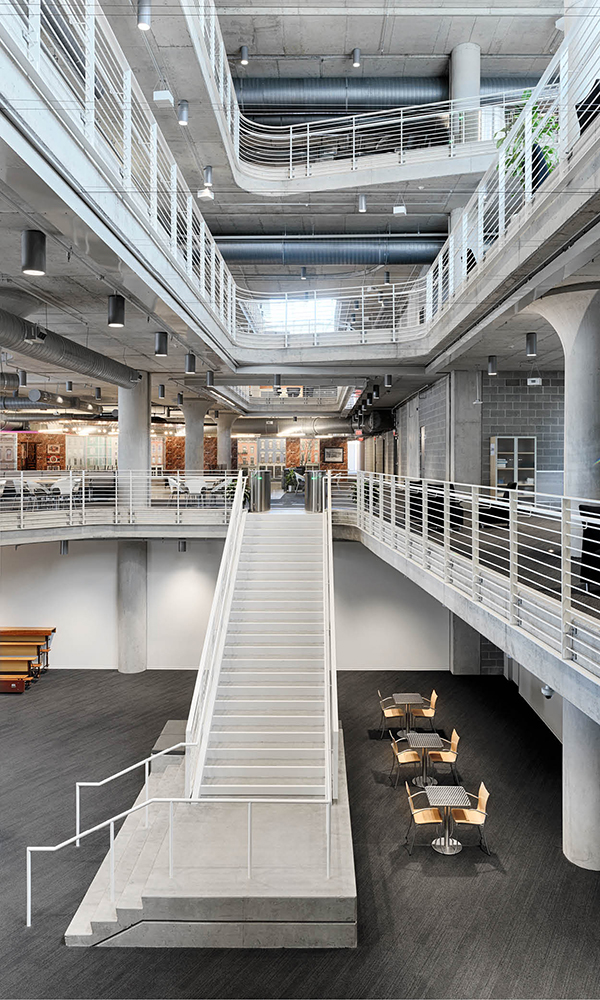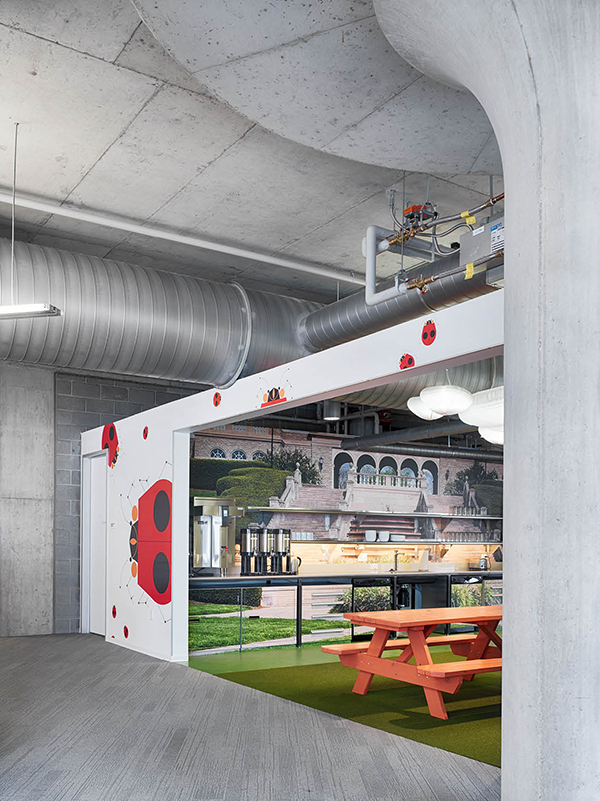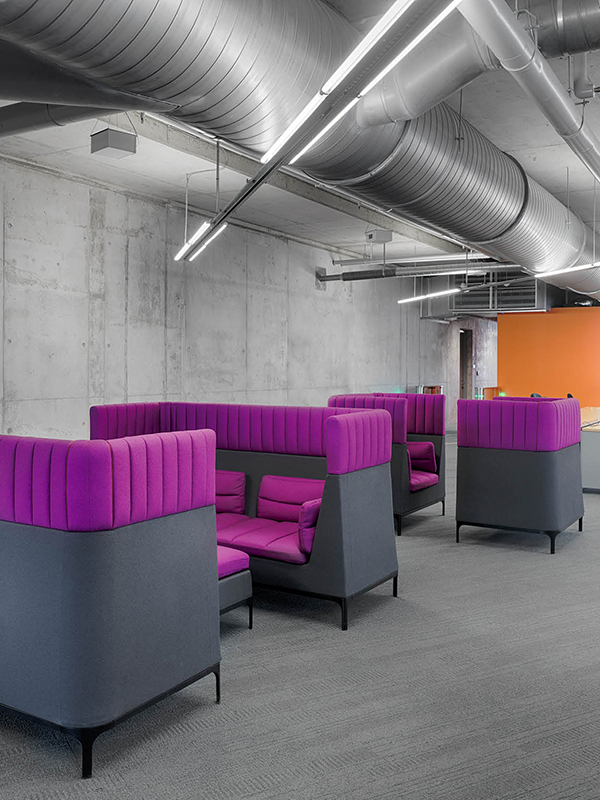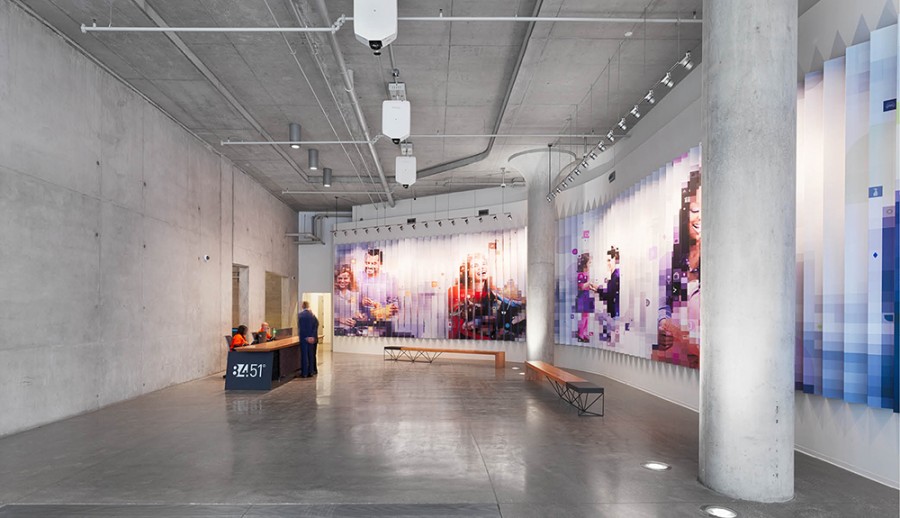Just off the beaten path, about a block west of Fountain Square, sits the newest addition to downtown Cincinnati’s skyline. At first glance it’s an unassuming union—a shadow, almost—of charcoal gray concrete board and glass. Irregular-shaped windows, louvered panels, and mesh screens punctuate the building’s facade, openings that some say make this building look like a giant zipper. Great zigzagging swaths of glass meander down from its roof, too, quietly indicating points of entry guarded by massive concrete pillars, a small hint at what visitors will find inside. Still, the glass has a way of softening an exterior that could otherwise be construed as heavy, even cold. In fact, this building’s windows reflect their surroundings so clearly—Macy’s, Saks, a cloudless blue sky beyond—that it’s hard in some places to see where the structure ends and the rest of the city’s skyline begins.

Photographs by Ryan Kurtz

Photographs by Ryan Kurtz
The building stretches a full block northward from the corner of Fifth and Race, but it exists neither to impose itself on the city nor to blend with its surroundings. It’s here, quite simply, to work. This is, after all, the new home of consumer research giant 84.51°, a space at once both simple and complex, a carefully orchestrated piece of architectural and interior design. 84.51° execs will tell anyone who asks that they paid a whole lot more attention to the structure’s interiors than they did to the outside. Maybe that’s why, on the day 100 West Fifth Street officially opens for business, some 24 months after it broke ground, it’s overflowing with people all itching for a peek inside.
Cincinnati Mayor John Cranley spoke for a lot of those at the building’s ribbon-cutting when he joked, “I don’t understand what you guys do.” An air of mystery surrounded the whole project: It’s there in the cypher-like company name, and in the gossip that circulated as the building went up. Rumors floated in the media that nobody who works in this new building will have a desk phone anymore. That there aren’t even any desks. No walled offices, either, and not one single solitary cubicle. Rumors that even the CEO sits at a plain old table, out in the open, just like everybody else.
What Cincinnatians don’t know yet is that the rumors are true. What they also don’t know is that this office building is, in fact, the future.
Ten steps into the building, graphic images start appearing at your feet—Facebook icons, text bubbles, pictures of food and coupons, and various colorful shapes. Projected from the ceiling, this “digital dust” is 84.51°’s own concoction—a representation of a generic consumer’s digital footprint that, like the real life stuff it’s meant to represent, follows you everywhere you go.

Photographs by Ryan Kurtz
Digital dust, as the company calls it, is also what 84.51° lives on. What brand of toilet paper do you use? Why do you buy generic yogurt but name brand eggs? Do you click on ads you see on Facebook? Do you prefer online coupons or paper? 84.51°—on behalf of Kroger (its biggest client, and since late April, now 84.51°’s owner, too)—cares about these things, and wants to know the answers. The answers, which can be found in mountains of customer data, obtained with simple things like Kroger Plus Cards, are crucial in studying shoppers’ behaviors, anticipating their needs, and pleasing today’s ever-changing customer base.
So when the company, which started in 2003 as a one-man offshoot of British parent dunnhumby Limited, grew to 310 employees by 2009 with no signs of stopping, they knew they needed a new home. They also knew they needed to work with Gensler—a San Francisco–based architecture firm that focuses on “client research-based design,” says Design Director/Design Principal Todd Heiser. Gensler can sometimes spend years working with clients, thinking about the ways in which they use their office spaces now and in the future, before they engage in the actual design process.
“There’s a fine line between a playground and a very modern office space that facilitates creativity. We’re not going to the Google side.”
Before 84.51° could decide what a new office space would look like, they needed to do extensive “time and motion studies,” says Dave Palm, the senior vice president of operations. “What percent of people’s time do they spend at their desk? What percent with clients? With peers?” The results of those studies paired with input from Gensler helped 84.51° understand, he says, “the environment that we’re really trying to create.”
That environment, they decided, was a place with no walls and no cubicles, no matter what a person’s title was. A place where collaboration was king, and where employees were valuable assets encouraged to think as freely and creatively as possible, and to feel as comfortable approaching top management as they are approaching their peers. In short, 84.51° decided to construct an entirely open office building.
Open offices are hardly a new concept. As Diane Stegmeier, author of Innovations in Office Design: The Critical Influence Approach to Effective Work Environments and founder of Berea, Ohio–based Stegmeier Consulting Group, points out, they’ve been around since the mid-1990s. Around 1996, she says, the Alcoa Company’s then-CEO made the switch at their headquarters in Pittsburgh. “[He] was frustrated with how much time it took to make decisions, how much time it took to schedule a meeting with top executives,” she says. So he took all of his top level execs out of walled offices—including himself—and placed them in cubicles. “Which at that point was so radical.”
Today, cubicles have morphed into “desking or benching systems,” says Stegmeier, and open offices are solidly gaining popularity. There are sizable examples already here in Greater Cincinnati—Total Quality Logistics has a 100,000-square-foot open office in Clermont County, and Paycor opened its 136,000-square-foot open office in Norwood last year. Big international firms like Google and Facebook have helped introduce the concept to Americans, too, thanks to media coverage of amenities like lap pools, indoor tube slides, and roof gardens with places to nap. For the record, Palm says, “There’s a fine line between a playground and a very modern office space that facilitates creativity. We’re not going to the Google side.” In other words, more work, less play.
On the surface the concept of an open office seems like just a trend. Not so, says Stegmeier. “Our studies have shown that people may only be at their desks about 43 percent of the day, on average. Yet companies are paying for a dedicated space to use it 100 percent of the time—and that rarely happens unless you are the security guard at the front desk [or] a receptionist.”
84.51° started experimenting with open plans in their previous building, an old post office at 444 West Third Street. First, things like walls and cubicles were replaced with long, table-like desks. When the office got a little too loud, they started piping in white noise—“background noise,” says Chris Richter, the company’s facilities manager—to even things out. (Otherwise, the volume in an open office quickly grows to a distracting dull roar and “next thing you know I can hear the conversation somebody’s having on the phone two rows over clear as day,” Richter notes.) Employees who needed blocks of quiet time were encouraged to move for an hour or a day—however long they needed—to designated meeting rooms and privacy booths. Soon, cool new pieces of furniture were brought in to try out, too: standing desks, treadmill desks, even high-back upholstered couches that provide comfortable and open—but semi-sound-proof—places to hold informal meetings or work quietly.
The reasoning behind such experiments? Company execs were trying to boost both productivity and employee morale. They also wanted to break down barriers between employees and management, and to promote idea-sharing and collaboration. The fastest way to do that, says Palm, was to remove walls. “Barriers,” he says, “slow things down. They block knowledge, they block insight, they block relationships. If you don’t have them, it makes life easier, faster.”
On one visit to the work-in-progress, construction workers were all over the 84.51° building like ants at a picnic. Palm had warned not to brush up against freshly painted metal railings even as, a few feet away, steelworkers were still fusing other parts of the same railing together with blowtorches. Dodging errant sparks, we toured the building, noting that—even amid the construction—some things were already done: the few walls (mostly for meeting rooms) had been painted, the floors covered in shades-of-gray angle-patterned carpet. Workers had recently finished assembling dozens of hanging mobile-like sculptures that on first glance are covered in more digital dust symbols, but when viewed from the right angle align to spell out the words LOYALTY and CUSTOMER FIRST. These pieces are suspended from the top of the “canyon”—a cavernous five-story stairwell in the center of the building with an expansive glass and steel-beamed roof overhead.
When all was said and done, says a reflective Palm, the growing pains were worth the experimentation and 84.51°execs felt validated in their decision to move to an open office. “For us,” he notes, “it’s not about driving productivity and being the slave master. It’s really about if we’re challenging our people to be more innovative.”
“When you talk about open plan,” says Todd Heiser, “there are so many clients that are still 20 percent or 30 percent private office—even 10 percent private office. 84.51° is zero percent private office.”
One of the keys to making such a vast, wall-less space work is dividing it in other ways. Gensler and 84.51°—whose offices span floors five through nine (one through four consist of commercial space and a parking garage)—selected different paint colors for different parts of the building, to “allow for way-finding,” says Heiser. But the architect’s main suggestion was to portion the building into three types of areas: neighborhoods, localities, and piazzas.
A neighborhood is basically an island of work tables clustered near each other. A group of neighborhoods is called a locality, and includes shared spaces like meeting and break rooms. Piazzas are “communal spaces” of various sizes that are sprinkled throughout the building, where employees can host clients, sit in on training sessions, or gather in large groups (the bulk of the eighth floor is one such space). Old-fashioned hallways as we know them are virtually non-existent; the idea of straight lines of traffic have been dissolved. Then again, Gensler’s very specific ways of dividing the space ensure that the building feels nothing like a giant warehouse, either. The meeting and break room walls are especially helpful in loosely dividing the space and creating some contour to the interior design.
“By creating those communities,” says Palm, “it kind of diminishes that ‘I’m just another corn stalk in the corn field’ [mentality].”
It’s a mentality easily assumed in a business like 84.51°—essentially a giant data processing center that is constantly gathering and dissecting information on hundreds of millions of shoppers worldwide. In this new building, 550 people sort, process, and interpret information about consumers’ shopping habits for parent company Kroger. (Previously dunnhumbyUSA’s largest client and 50 percent owner, Kroger bought the other half of the company outright earlier this year and changed the name to 84.51°. The change was a nod to the building’s longitude, albeit an awkward one, as acknowledged by Mayor Cranley when he called it “867-5309” at the ribbon cutting.)
Data management, processing, and interpretation is hardly “creative” work, and yet the design of the company’s office space and the freedom its employees receive is akin to something you might see in less structured places, like ad agencies. 84.51° employees are allowed—encouraged, even—to leave their own neighborhoods, localities, and piazzas, and explore others whenever they like (each locality has its own coffee/tea space, with unique themes like Over-the-Rhine, Flying Pigs, local parks, and Cincinnati sports teams, in order to attract just such commingling). On nice days employees may even work outside on one of the building’s multiple balconies, including the 3,000-square-foot roof deck adjoining the floor-to-ceiling windowed ninth floor lobby. (84.51° execs chose this unexpected place—the building’s top floor—as their main reception space because of the sweeping city views it offers. “We didn’t just want it to be for special events,” says Palm.)

Photographs by Ryan Kurtz
Technology, especially in the way it makes paper unnecessary, has played a huge role in the rising popularity of open offices. With most file storage existing primarily digitally today (instead of in big bulky file cabinets), companies have significantly more space for things like break rooms and flexible seating. The real key to making an open office work, though, is having enough private spaces where people can go for “heads-down,” focused work when needed, says Palm. According to Stegmeier, a common complaint clients have after converting to an open office is that they didn’t allot enough space for such rooms upfront. 84.51° execs learned this pretty quickly while experimenting with the concept in their previous building. By the time they moved out, “literally people were fighting for meeting space,” says Richter. The number of meeting rooms has more than doubled in this new space and now numbers close to 200. They vary hugely in size from one-person privacy booths to a divisible, 300-person theater-style meeting space.
When asked if anyone has ever moved into a privacy booth and refused to come out, Palm laughs, noting that the company’s turnover rates with analysts—typically a highly introverted population—is quite low. The key, he explains, is that “you have to have the right mix of space types in order to accommodate” different people with different work styles at different times throughout the day.
It is kind of puzzling to think about a CEO sitting right out in the open, handling confidential company business in front of anyone who happens to sit—or walk—by. And, of course, corporate necessities like annual reviews require private rooms, too. What’s Stegmeier’s take on the new normal? “Once a year in December you can have eight meetings,” in a meeting room; the rest of the time, you’re probably fine sitting out next to everyone else. Even if you are the Big Cheese.
The hardest stereotype to overcome is that open offices are hubs of mass chaos, says Stegmeier. “People tend to think that ‘open’ means it’s a circus tent—everything’s going on: the color, the movement, the sound, no visual barriers,” she says, “and that’s just not true. I will tell you I have walked through open office environments that are more quiet, more peaceful than a library.”
For instance, you might not think it’d be quiet sitting in one of 84.51°’s fuchsia, high-back upholstered benches facing an identical bench set mere feet away.

Photographs by Ryan Kurtz
But these two pieces of furniture have been engineered to reduce sound when facing each other just like this, and somehow, they really do. Inside, voices become muted and you feel a definite sense that you are removed from the hubbub of the rest of the office. In a mini conference room, of sorts.
84.51° has not quite reached library status yet (nor are there any indications that they’re trying). They’ve addressed general noise concerns in the new building by installing sound-absorbing baffles in conference room ceilings and—as before—piping white noise throughout the building. Headphones help, too. “Our assistant sits next to Stuart [Aitken, the company’s CEO] and across from me,” says Palm. “I give her a Koosh ball and say: ‘If I have my headphones on, just feel free to throw the Koosh ball at me to get my attention.’ ”
Although “the open office is not for everyone,” says Stegmeier, companies oftentimes find it a big attractor for younger employees who are looking for a total workplace experience, especially since they spend so many of their waking hours at the office. They like the opportunity for collaboration and access to top execs. Modern day perks like a fitness center with massage rooms and yoga classrooms don’t hurt either (84.51° has both). But what they like best, says Stegmeier, is the sense of balance and freedom they can’t find in more traditionally structured offices. The ability to grab your laptop and work in the company café, much like a freelancer would, is appealing to today’s top talent, she says. Ditto for the ability to spend part of your workday curled up in a comfortable chair with your laptop at a window overlooking downtown. “Corporations are becoming more cognizant that work can be productive regardless of where it is,” she says, “as long as people have the right habits and are trained to not be so distracted by noise and visuals.”
This raises two questions: First, is this kind of workspace best for more youth-centric companies? A quick tour of the company’s offices reveals very little gray hair. Palm, himself in the middle-aged minority, admits that “some people have said we’re younger relative to the general population of Cincinnati.”
And second: Is catering to a younger audience a sound business principle? In a recent Wall Street Journal article, Lindsey Gellman noted that “millennials—those roughly 18 to 34 years old—make up the largest share of the U.S. workforce.” Gellman also noted, though, that “last year, the median job tenure for workers aged 20 to 24 was shorter than 16 months. For those aged 25 to 34, it was three years.” An open office is a major investment for a group of people who’ll potentially be leaving your company any time between now and 2018.
Once you understand what an open office is, you can begin to understand why Gensler and 84.51° designed the building the way they did. It’s not a stretch when Todd Heiser describes this place as “bespoke.” As in: Custom tailored. Fitted like a very fine suit.
Here, people work on teams, and client leaders work hand-in-hand with analysts sharing data and pertinent information on various projects throughout the day. Company spokesperson Ann Keeling offers this example: “Team members work with clients to determine offers that will benefit specific customers. Other members write copy, develop the design and layout, identify the best customers that will benefit from the offer, [and] ensure coupons are coded correctly and are set to scan correctly in your local Kroger store.” The kind of work 84.51° does “takes a variety of experts,” she says, all working together at once.
In order to make the workplace accommodate such a collaborative style, it was critical, say Heiser and Tim Jacobson, a senior associate at Gensler who worked on the project, that this building have “flexible bones.”
“To us, the exterior is the least important part of the building. Our highest priority was how do people work and how do we want people to work in the future?”
Instead of desks, each employee shares a table with several other employees and has a three-drawer rolling cart that they can move to any workstation at will. (And that high-backed sound-muffling seating is quite portable, with many hands.) Plus, the raised tile floors are hollow so computers can be moved and connected elsewhere at moment’s notice. “It gives us complete flexibility,” says Richter. “We can maneuver and manipulate as we need with minimum distraction to the business.”
The centerpiece of the building’s interior is definitively that giant, glass-topped open staircase affectionately known as The Canyon. It floods all five floors of 84.51°’s space with natural light and provides views of the downtown skyline, too. (Jacobson, the building’s main architect, notes that employees working on the lowest level—the fifth floor—can see Carew Tower through the ninth floor skylight.) But at 84.51° there is an ulterior motive to letting it shine throughout as well. “We decided, through the architecture, we would use light to force people to move through the building and interact with their colleagues,” says Heiser. In other words, they’re hoping most employees will opt to take the stairs instead of the elevators (which consume energy and contribute nothing to personal fitness and employee connectivity—a biggie in a collaborative office environment).
As at the street-level entry, the most visible material feature of the entire building—which boasts the largest floor plates in downtown at 70,000 square feet per floor, according to the folks at Gensler—is unfinished concrete. In fact, the nearly 1,000 martini glass–shaped concrete pillars that dot the building’s floorplan (a definite nod to Frank Lloyd Wright’s lily pad columns at the S.C. Johnson headquarters) seem to be the architect’s one aesthetic indulgence not tied to the open office agenda. Granted, they do serve a higher purpose—holding up the building.

Photograph by Ryan Kurtz
And then there’s the facade—that staggered grey and glass exterior that so many people think looks like a zipper. Those windows have been designed, says Jacobson, to be a metaphor for the data. In just the way no two windows appear to be the same size or shape, no two customers’ data is the same, either. In fact, says Jacobson, the windows “help 84.51° itself start to leak through to the outside. The same way we’re working within our floor plate to try and make these connections, our facade then acts as the piece that creates a relationship between the city and the individual and back.”
“We created this building inside out,” says Palm. “To us, the exterior is the least important part of the building. Our highest priority was how do people work and how do we want people to work in the future?”
When Kroger took hold of the company’s reins this past spring, some people wondered if 84.51° would really stay a 100 percent open office. After all, Kroger’s corporate headquarters in that nondescript gray rectangular building just north on Vine Street are pretty much the antithesis of 84.51°’s—basic, traditional, cube-infested, and most definitely walled.
Kroger execs remain silent on whether they’ll make changes (they declined to be interviewed for this story), but so far not one single wall, all of which are painted in dunnhumby’s signature colors—pumpkin, sage, teal, and fuchsia—has been added or touched. Given that Kroger has always owned 50 percent of the company anyway, and that, per Palm, “a very large percentage” of dunnhumbyUSA’s Cincinnati office was always focused solely on Kroger to begin with, the future of 84.51°’s open office seems stable for now.
Truth be told, Kroger’s purchase of 84.51° feels to insiders a little bit like consummating a marriage. After all, Palm says his security badge has always worked in Kroger’s corporate offices, and Kroger employees have always been allowed to use dunnhumby’s fitness center at will. And Kroger Personal Finance has, from day one, been slated to move into the building’s fifth floor (where they’ve designed their portion of the building to include walled offices).
The rest of the structure, meantime, is working hard at fitting in downtown. 3CDC manages its public parking garage (which is owned by the city), but it also owns all of the building’s first floor commercial space, which has been subdivided into five usable storefronts. All are currently vacant, but Anastasia Mileham, 3CDC’s communications czar, says they’re “currently mostly negotiating with food service establishments” for these spaces. Takers include Joe Lanni, cofounder of Thunderdome Restaurant Group (creators of Bakersfield and The Eagle); Cristian Pietoso, chef and owner of Via Vite, who plans to expand his horizons by opening a “burger joint”; and Jose Salazar, who is working on a Latin-cuisine restaurant called Mita’s.
The restaurants are expected to open in late summer/early fall, with Mita’s at the lead. Back up on floors five through nine, however, things are humming along nicely right now. Rarely has an office been designed with so much focus on the employees’ comfort and well-being, fulfilling almost every workday need, and then some. The space feels fun without feeling crazy. Uplifting and energetic, even. In other words, it really doesn’t feel a whole lot like “work.”
As the elevators transition you down from the urban-tree-house-style ninth floor lobby, through the high-tech security bays and back into the building’s street-level foyer, polished concrete floors and those little projections of digital dust dancing at your feet are the only remnants of the bright, open, and—dare we say it?—“happy” place that exists upstairs. Walking back out onto Fifth Street—beige sidewalks blending into building after building, and people walking hurriedly by, heads down—is kind of jarring after a few hours at 84.51°. A little less planned, a little less fitted, a little less certain than the place you’d found inside.





Facebook Comments